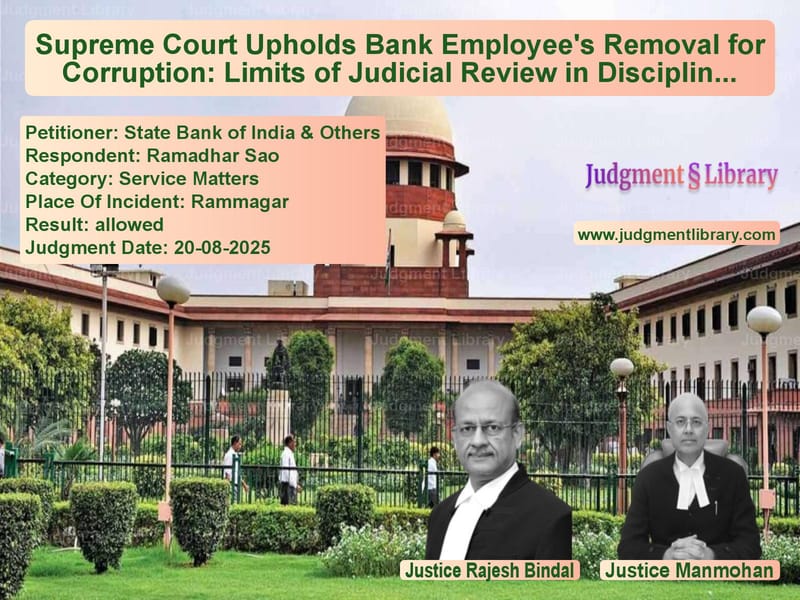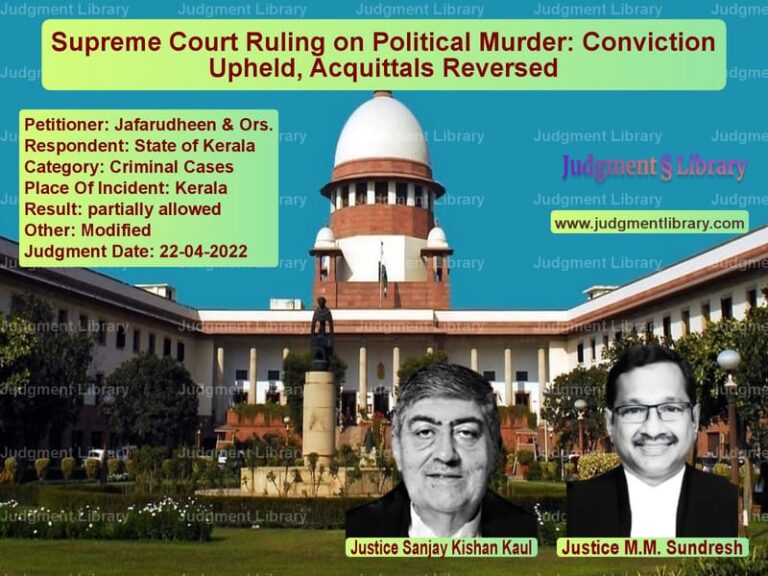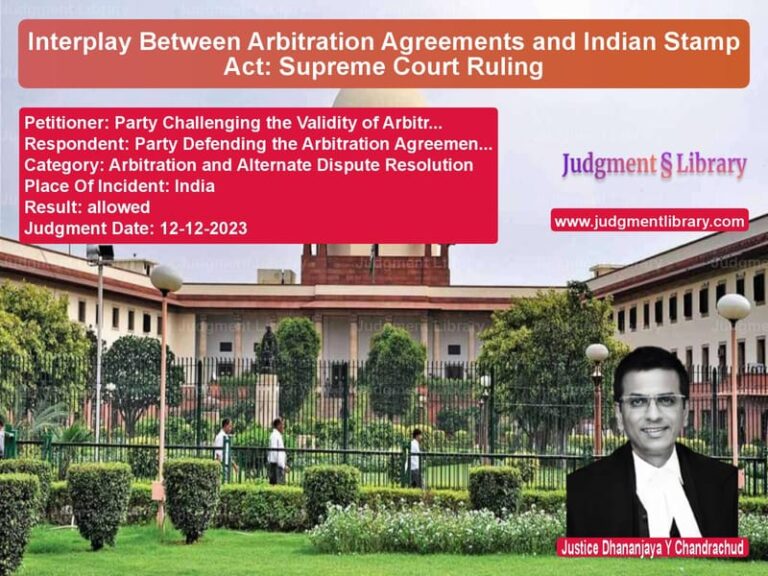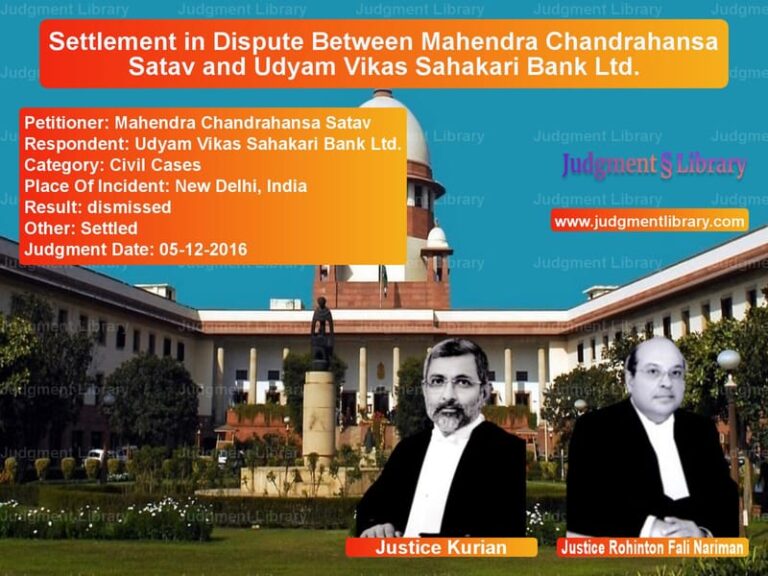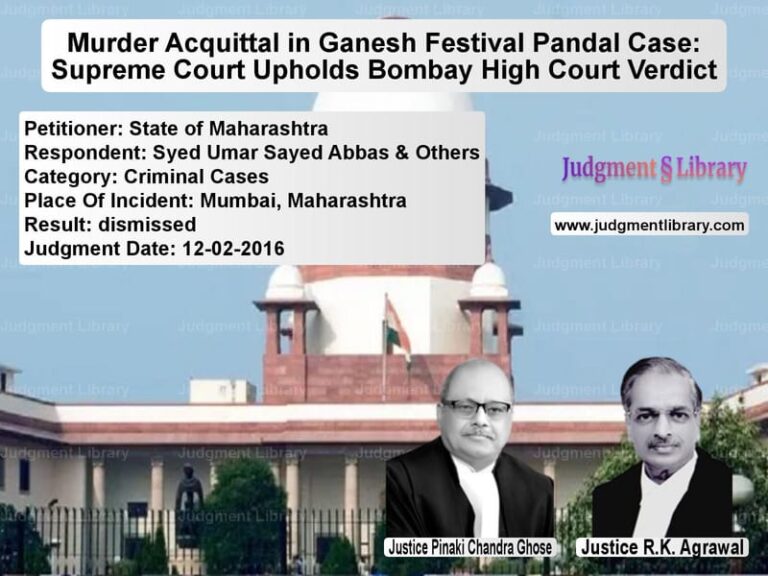Supreme Court Upholds Bank Employee’s Removal for Corruption: Limits of Judicial Review in Disciplinary Matters
In a significant ruling that clarifies the boundaries of judicial intervention in disciplinary matters, the Supreme Court of India has reinstated the punishment of a State Bank of India employee who was found guilty of acting as a middleman in loan sanctioning and accepting illegal gratification. The judgment overturns the decisions of both the Single Bench and Division Bench of the Patna High Court, which had set aside the employee’s removal from service.
The case involved Ramadhar Sao, who joined the State Bank of India as a messenger in 1997. In 2008, complaints surfaced alleging that Sao was taking bribes for coordinating in the sanction of loans. The Bank initiated disciplinary proceedings against him, culminating in his dismissal from service in 2011. The Appellate Authority later reduced this punishment to “removal from service” with superannuation benefits, taking a compassionate view of the matter.
Despite this reduction in punishment, Sao approached the Patna High Court, which completely set aside the disciplinary action and ordered his reinstatement with back wages. The Bank’s appeal against this decision was dismissed by the Division Bench, leading to the present appeal before the Supreme Court.
The appellants, State Bank of India and others, represented by their counsel, made several compelling arguments challenging the High Court’s intervention. “Learned counsel for the appellants submitted that the Division Bench of the High Court has failed to take notice of the facts of the case correctly.” The Bank argued that the High Court had confused the initial show cause notice with the formal chargesheet, leading to an incorrect appreciation of the facts.
The Bank’s counsel emphasized that “It is a case in which the Appellate Authority had already taken a compassionate view while reducing the penalty from ‘dismissal’ to ‘removal from service’ with superannuation benefits.” This highlighted that the employee had already received considerable leniency from the Bank’s internal mechanisms.
A crucial legal argument advanced by the Bank was regarding the scope of judicial review in disciplinary matters. “It was further argued that the scope of interference in a writ petition against the departmental proceedings is not like an appeal. In judicial review, only procedural aspect could be examined.” The Bank stressed that “It is not the case of the respondent that there was any violation of principles of natural justice as he participated in the inquiry and cross-examined the witnesses.”
The Bank also countered the High Court’s observation that Sao had been made a scapegoat, stating that “In fact, two other officers, the Branch Manager and Field Officer involved with the respondent were punished with removal from service.” This demonstrated that the Bank had taken action against all involved parties, not just the junior employee.
On the other side, Ramadhar Sao’s counsel presented arguments focusing on his junior position and alleged unfair targeting. “Learned counsel for the respondent submitted that the respondent has been made a scapegoat in the case. He was merely a class IV employee at lowest level. His primary job was printing of passbooks. He had no authority either to file, process or sanction any loan.”
Sao’s counsel argued that “If any irregularity was there, for that senior officers in the Bank could be held responsible and not the respondent.” This position sought to shift responsibility to higher-ranking officials who had greater authority in the loan sanctioning process.
Interestingly, Sao’s counsel also pointed to his subsequent promotion as evidence of his good conduct, stating that “It is evident from a letter dated 20.09.2010, i.e. after the alleged incident, the respondent was promoted to the post of Assistant. This shows that his work and conduct was good.”
Facing the prospect of prolonged litigation, Sao’s counsel made a pragmatic suggestion: “Even now, to put closure to the litigation, seeing the plight of the respondent who was a class IV employee, the relief granted to him can be moulded, may be by reducing the back wages.”
The Supreme Court, in its judgment delivered by Justice Rajesh Bindal with Justice Manmohan concurring, conducted a thorough examination of the evidence and legal principles. The court noted that the charges against Sao were serious and well-documented: “He acted as a middleman in sanction of loans.” The chargesheet specifically alleged that “You were allegedly acting as a middleman in loan sanction and disbursement at the branch. You are charged of taking illegal gratification from a customer of the Bank.”
The court found compelling evidence against Sao, noting that “The loanees of the Bank appeared as departmental witnesses in the Inquiry.” The judgment recorded that “PW-1/Fakruddin stated that he was forced to pay ₹ 5000/- to the respondent for getting his loan sanctioned without even proper documents. Similar were the statements made by PW-2, PW-3. PW-4 and PW-5, all of whom had stated about giving several thousands to respondent in order to get their loans sanctioned.”
Perhaps the most damning evidence came from Sao’s own statement before the Disciplinary Authority, which the court reproduced: “I am innocent. Knowingly or unknowingly whatever mistake I have made, please forgive me. One of my son is handicapped and one of my daughter is of marriageable age. I have always served the Bank with utmost satisfaction. I don’t have any other source of income.” The court observed that “The aforesaid statement established the fact that indirectly the respondent had admitted what he had done. He pleaded mercy.”
The Supreme Court extensively discussed the legal principles governing judicial review in disciplinary matters. Quoting from its earlier decision in SBI v. Ajai Kumar Srivastava, the court emphasized: “The power of judicial review in the matters of disciplinary inquiries, exercised by the departmental/appellate authorities discharged by constitutional courts under Article 226 or Article 32 or Article 136 of the Constitution of India is circumscribed by limits of correcting errors of law or procedural errors leading to manifest injustice or violation of principles of natural justice and it is not akin to adjudication of the case on merits as an appellate authority.”
The court also referenced Boloram Bordoloi v. Lakhimi Gaolia Bank, noting that “it is well settled that if the disciplinary authority accepts the findings recorded by the enquiry officer and passes an order, no detailed reasons are required to be recorded in the order imposing punishment.”
The Supreme Court systematically addressed each of the High Court’s reasons for setting aside the punishment. Regarding the Single Bench’s observation that the findings were based on “conjuncture and surmises,” the court held: “The opinion expressed by the Single Bench that the finding recorded by the Inquiry Officer and the Disciplinary Authority were based on conjuncture and surmises, cannot be legally sustained. It is for the reason that if entire evidence is perused, there was no error in the findings record. These were based on preponderance of probabilities and strict proof of evidence beyond reasonable doubt was not required.”
The court also rejected the High Court’s finding that Sao had been made a scapegoat, stating: “Another reason assigned by the Single Bench is that the respondent has been made the scapegoat and other senior officers have not been proceeded against, is also wrong as the stand taken by the Bank is that the Branch Manager and the Field Officer against whom allegations were leveled along with the respondent, were removed from service.”
The Supreme Court emphasized that “It is not the case of the respondent that there was violation of principles of natural justice. Meaning thereby, due process was followed during the course of inquiry.” This finding was crucial in determining that the disciplinary proceedings had been conducted fairly and in accordance with established procedures.
In its concluding observations, the court noted that “In fact, leniency was shown by the Appellate Authority by reducing the penalty from ‘dismissal’ to ‘removal from service’ with superannuation benefits.” This highlighted that the employee had already received considerable benefit from the Bank’s internal appellate process.
The Supreme Court’s judgment reinforces important principles about the relationship between judicial review and disciplinary proceedings. It clarifies that courts should not substitute their own judgment for that of disciplinary authorities when due process has been followed and there is evidence to support the findings. The decision serves as a reminder that in cases involving corruption, even junior employees cannot escape responsibility for their actions, particularly when there is direct evidence of their involvement in misconduct.
This ruling is significant for public sector banks and other government organizations as it affirms their authority to take disciplinary action against employees involved in corrupt practices, while also defining the boundaries within which courts can intervene in such matters.
Petitioner Name: State Bank of India & Others.Respondent Name: Ramadhar Sao.Judgment By: Justice Rajesh Bindal, Justice Manmohan.Place Of Incident: Rammagar.Judgment Date: 20-08-2025.Result: allowed.
Don’t miss out on the full details! Download the complete judgment in PDF format below and gain valuable insights instantly!
Download Judgment: state-bank-of-india-vs-ramadhar-sao-supreme-court-of-india-judgment-dated-20-08-2025.pdf
Directly Download Judgment: Directly download this Judgment
See all petitions in Disciplinary Proceedings
See all petitions in Termination Cases
See all petitions in Employment Disputes
See all petitions in Public Sector Employees
See all petitions in Judgment by Rajesh Bindal
See all petitions in Judgment by Manmohan
See all petitions in allowed
See all petitions in supreme court of India judgments August 2025
See all petitions in 2025 judgments
See all posts in Service Matters Category
See all allowed petitions in Service Matters Category
See all Dismissed petitions in Service Matters Category
See all partially allowed petitions in Service Matters Category

